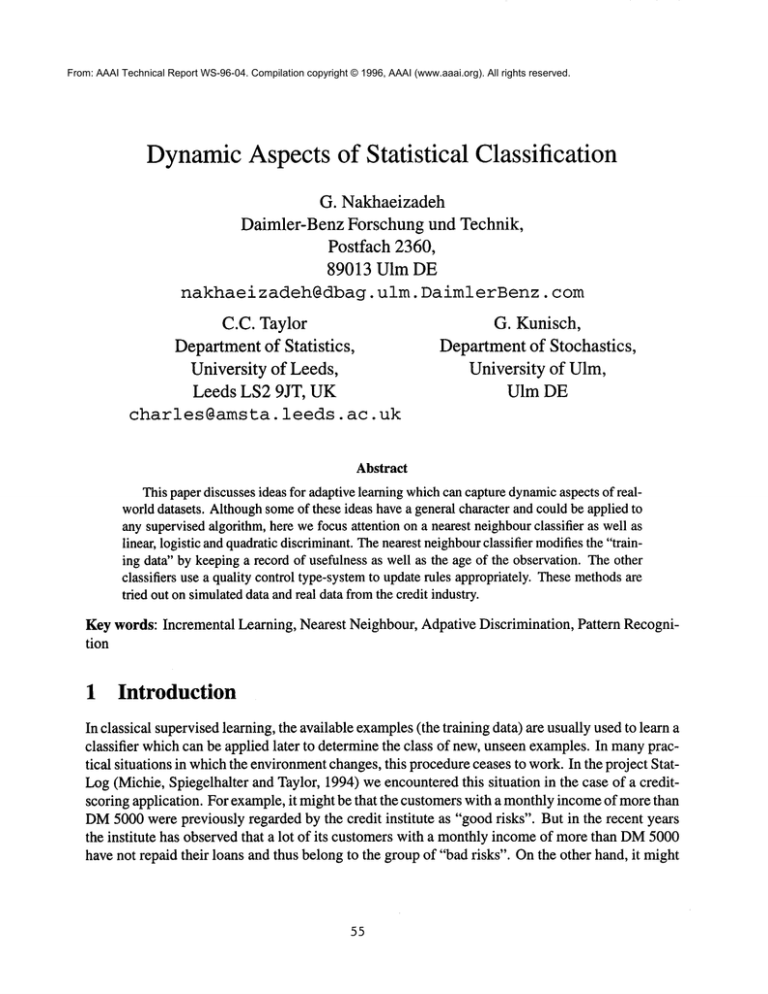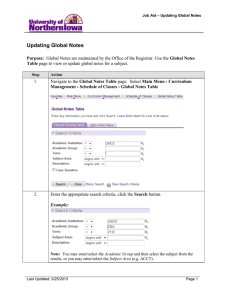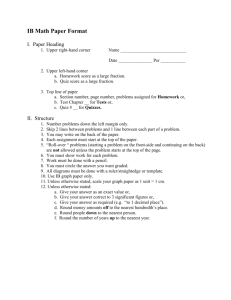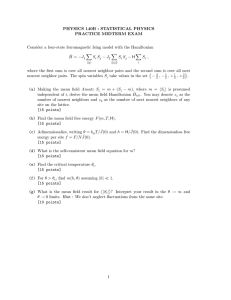
From: AAAI Technical Report WS-96-04. Compilation copyright © 1996, AAAI (www.aaai.org). All rights reserved.
Dynamic
Aspects of Statistical Classification
G. Nakhaeizadeh
Daimler-BenzForschungund Technik,
Postfach 2360,
89013 Ulm DE
nakhae
i z adeh@dbag,
ulm. Daiml erBenz,
C.C. Taylor
Department
of Statistics,
University of Leeds,
Leeds LS2 9JT, UK
charles@amsta,
leeds,
com
G. Kunisch,
Departmentof Stochastics,
University of Ulm,
Ulm DE
ac°
uk
Abstract
This paper discusses ideas for adaptive learning whichcan capture dynamicaspects of realworld datasets. Althoughsomeof these ideas have a general character and could be applied to
any supervised algorithm, here wefocus attention on a nearest neighbourclassifier as well as
linear, logistic and quadratic discriminant. Thenearest neighbourclassifier modifiesthe "training data" by keeping a record of usefulness as well as the age of the observation. The other
classifiers use a quality control type-systemto update rules appropriately. These methodsare
tried out on simulateddata and real data fromthe credit industry.
Key words: Incremental Learning, Nearest Neighbour, Adpative Discrimination,
tion
1
Pattern Recogni-
Introduction
In classical supervised learning, the available examples(the training data) are usually used to learn
classifier which can be applied later to determine the class of new, unseen examples. In manypractical situations in which the environmentchanges, this procedure ceases to work. In the project StatLog (Michie, Spiegelhalter and Taylor, 1994) we encountered this situation in the case of a creditscoring application. For example, it might be that the customers with a monthly income of more than
DM5000 were previously regarded by the credit institute as "good risks". But in the recent years
the institute has observed that a lot of its customers with a monthly income of more than DM5000
have not repaid their loans and thus belong to the group of "bad risks". On the other hand, it might
55
be that due to strong competitionwhichexists in the credit market, the credit institute has had to
reduce the threshold for monthly incomefrom DM5000 to DM4000 to be able to give moreloans.
It meansthat a customer whohas a monthly income of DM4000 and was up to nowregarded as a
"bad risk" is noweligible for credit.
Generally speaking, the application of a discrimination algorithm to classify new, unseen exampies will be problematicif one of the followingevents occurs after the "learning phase":
1. Thenumberof attributes changes. Wehave experiencedthis case in a credit-scoring application that certain customerinformation can no longer be stored due to legal requirements. On
the other hand, it has also been the case that one is able to get moreinformationthan before
about the customers,i.e. one can consider moreattributes.
2. Thenumberof attributes remainsthe samebut the interpretation of the records of the datasets
changesover the time. In this situation the distribution of at least one class is graduallychanging. As mentionedabove, the changes of the paymentbehaviour of customers in the case of
credit-scoring or the changesof the diagnosis device in the case of automatic transmissions
are examplesof this problem(see Michieet al. (1994), chapter 9).
To solve this problemone could simply relearn the rule provided that there are enoughnewexampies with knownclass, but this could be very wasteful. Analternative is Incrementallearning. For
example, Utgoff (1989) has developed an algorithm that produces the samedecision tree as would
be found if all the exampleshad been available at once, and Utgoff (1994) has recently devised
improvedalgorithm (ITI) whichcan handle continuousvariables, multiple classes, noise etc.. However, this cannot deal with the problemin item 2 abovesince someof the old data should be downweightedor discarded as no longer being representative of the current population.
Filosofov (1992) gives somegeneral principles for the developmentof classification systemsfor
dynamicobjects with variable properties that are observed under changingconditions. He outlines
the following requirements for dynamicclassification systems: to handle changing compositionof
features, different feature types, and varyingaccuracyand statistical characteristics of observations;
to give precedencein time and quantitatively changeproximity of the object to a particular class;
to rely on a single prior description of objects or processes. Healso outlines three stages in the
classification process: prepare the input data for executionof the next classification cycle; execute
the classification cycle; augmentthe available information about the objects with newdata. The
approach, whichis fairly general, uses conditional probabilities. He concludesby recommending
a
hierarchical systemfor classification of dynamicobjects, retaining a cataloguethat stores the results
of past observations,and generalizeddistributions of features on one of the classification levels.
Joseph and Hanratty (1993) explore the concept of incremental learning using Artificial Neural
Networks(ANNs)to provide on-line adaptation to changingprocess conditions in a quality control
application. Twokey ingredients are: the forgetting factor (howfast the network modelshould
discount old data) in which past measurementsare often weighted with an exponential decay; an
updating algorithm whichcan takes a numberof forms (randomlyreplace a part of the training set
with the newdata, replace the oldest training data with newdata or replace the oldest training data
that has similar operating conditions(i.e. class) as the newdata).
56
A closely related topic is that of drifting concepts. For example,early workwasdone by Schlimmer and Granger (1986) with his STAGGERsystem. See also Schlimmer(1987) and more recent
work by Kubat and Widmer(1995). De Raedt and Bruynooghe (1992) argue that incremental
concept-learning -- whenformulated in a logical framework-- can be understood as an instance
of the moregeneral problemof belief updating. This insight allows for potential interesting crossfertilization betweenthese areas.
This paper considers the situation described in item 2 above, namelythat the distributions of
the classes maybe changing over time. Broadly, we explore two approaches. The first examines
waysof updating the classification rule as suggested by somemonitoring process. Thesecond examinesa (nearest neighbour)classifier based explicitly on the data and waysin whichthe data can
be dynamically adapted to improvethe performance.
2
Monitoring Process
2.1
Introduction
In order to makevisible howthe allocation rule worksit is necessary to observe somevalues regularly. This is what we meanby the expression process monitoring. In this case batches of observations should be taken to monitor the performanceof the classifier or any changein the class
populations. There are several quantities that could be monitored:
1. the average probability of (maximum)
class membership- if this is drifting downwards(towards1/q wherethere are q classes) then adaptation is required;
2. the meansand covariances of the most recent batch of observations for each class;
3. the error rates (assumingthat the class is known);
4. the estimated prior groupprobabilities (if the observeddata is acquired by mixturesampling).
Thesecan be plotted in time-series fashion, with appropriate warningand action limits indicating
that the process has changed.In this scenario weenvisagethat the learning will be doneat discrete
time points, preferably (but not necessarily) using the previous rule to find an updatedrule. This
approachenables us to modellarge suddenchangesin the populations. A significant changedetected
by the measuresin 1. and 2. aboveis a warning sign whichsuggests that the classifier should be
adapted. If, in addition, the measureused in 3. is also significantly changing,then the necessity to
adapt the algorithm is morepronounced.If it is the case that 1. and 2. suggest that an adaptation
is required, but measure3. is apparently not changing, then a moreappropriate learning algorithm
maybe warranted.
2.2
Warningand Action Limits
In the absenceof any theoretical results on standarderrors for estimatederror rates, whichare available for normal-baseddiscrimination procedures; see McLachlan(1992) for example,a general ap-
57
proach using a Shewhartquality control chart can be implemented.Smith(1994) discusses the use
of quality control chart in a neural networksetting.
Tests of the meanand variance of each class can use Hotelling’s T~ and Box’s M-test respectively; see Mardia,Kent and Bibby(1979). In this case, since the monitoringis for a multivariate
quantity wemayplot the actual test statistics in the first instance. If a deviantbatch is detected then
wecould carry out further diagnostics to investigate whichof the attributes has changed.Although
these tests makeNormaldistribution assumptions,they can also be used for the nonparametricclassification methodsjust for monitoring purposes. Analternative nonparametricversion wouldbe to
use a multivariate version of the Kolmogorov-Smirnov
test which detects whether there has been
any changein the distribution.
3
Changingthe Classifier
In this section wediscuss waysof updatingthe classifier either by explicitly changingthe rule which
has been learned, or by changingthe learning data by substituting or adding morerecent observations. Supposethat we examinethe data in batches of size m and that, at time t +mkwedetect a
change whichrequires adaptation in the learned rule. Anyalgorithm can be totally relearned from
recent observations after a changein one of the classes has been detected. Moreinterestingly, we
can consider howbest to re-use previously learned information.
3.1
Updating the "rules"
Onemethodis to allow the weights to dependon the performanceof the classifier. Supposethat we
havea current rule whichis used on the next batch of observations and results in an error rate of
e,,~,~. Supposealso that if the newdata is used to obtain a rule, then this wouldgive an error rate
for this batch of e,~, althoughthis rate could be badly biased, since the training and test data are
the same.If these error rates are very different this suggeststhat the current rule shouldbe updated.
Oneapproachis to obtain a revised rule whichis a weightedaverage of these two rules with weights
proportional to 1 - e~e,~t and 1 - e,~e~. Anotherpossibility is to build an error rule from previous
error rates and comparethe current error e~,~ to that or somefunction thereof.
Figure 1 illustrates the process. Aninitial learning phase learns the required parametersas well
as estimating an error rate by cross-validation. Thetest data is then classified in batches. According
to the size of the error rate there maybe total re-learning or merelyadjustmentof the current rules
if the changeis deemedto be small. In the case that the error rate is less than the norm,no updating
is carried out.
3.2
Updating the "data"
Wecan use a "similarity" rule to throwawayobservationsin the current training set whichare different - i.e. they are close in feature space, but havedifferent class label - fromthose recently observed. Alternatively, the older observations can be eliminated or a kind of movingwindowwith a
predefined numberof observations, possibly representative and newones, could be used. Figure 2
58
test data,
I
movingwindow:
datausedfor
establishing
rule
allocation
rule
dassificaUon
dght
or high
probabilities
of
classmere
,bership
i
adddata
.....................
classificationwrong
or now
probabilities
of
class membership
’, discard
data
J
discardolddata
..........................................
>.
Waste
Figure1: Learningby error reaction
Figure 2: Learningby data manipulation
illustrates a possible implementation
wherebyold data are discardedand newdata are includedin
the "template"used for establishing a rule accordingto their perceivedusefulness. As presented,
this systemwill havesomelimitations. Forexample,if there are drifting populationsthen newdata
will be incorrectlyclassified, but shouldneverthelessbe includedin the templateset. Thispoint is
takenup in a nearest neighbourimplementation
in section 4.2. Notethat this approachcan be used
for any(not just similarity-based)algorithms.
4
4.1
Algorithm Details
Updating rules
Forlogistic, quadraticandlinear discriminationwehaveimplemented
a type of quality control systemin whichthe error rate is monitored.Thereare variousscenarios:
¯ in the case of smallincreasesin error, the rule is updated;
¯ in the case of large increases, the rule is re-learnedonly using the mostrecent batchof data;
¯ in the case of small decreasesin error, no changeis madeto the existing classifier.
Full details of the abovemethodsare given in (Nakhaeizadeh
et al. , 1996) whoin addition use
movingwindow
to retain a goodtemplateset to estimatethe quadraticdiscriminantrule. Asimilar
approachwas also used by Gibb,AuslanderandGriffin (1994) whopartitioned their data into three
groups:a template set, a training set anda test set. Thetemplateset wasusedfor feature selection. After feature selection andparameterestimationthe algorithmclassifies observationsin the
test set. If a gradualdrift is detectedthe mostrecentlyclassified objectis addedto the templateset,
the feature selection processis repeatedandthe parameters
re-estimatedfromthe training set. In
their application,the true class of the observationsin the test set is neverrevealedto the algorithm,
so thereis a risk that misclassifiedobjects canbe addedto the template,thus contaminating
it.
59
4.2
Updating data
A dynamic1-nearest neighbour algorithm has been developed in which examplesare given a nominal weightof 1 whenthey are first observed.Thenall observations"age" at a rate A, to allow for the
fact that in a dynamicsystemolder examplesare likely to be less useful. In addition, future examples
whichare classified affect the existing weightsso that:
(i) If the newobservationis correctly classified by the nearest neighbour,but wouldbe incorrectly
classified by the secondnearest neighbour,then the nearest neighbourgets its weightincreased
by 7 (a sort of condensingfactor).
(ii) If the newobservation is incorrectly classified by the nearest neighbour,but wouldhave been
correctly classified by the secondnearest neighbour,then the nearest neighbourgets its weight
decreasedby e (a sort of editing factor).
This approachessentially keeps a "record of usefulness" 1 for each of the observationsin the current
training set.
The weight, w(x), of each examplethen behaves like a MarkovChain with an absorbing barrier at 0, whoseproperties can be studied in order to get someidea of suitable choices for the three
parameters:A, 3, and e. For example,the drift of the weightof an example,say at x, is
drift(w(z))
= -A + 7p(x) -
wherep(x) is the probability that this examplewill be the nearest observation to the next example
and that the situation describedin (i) aboveoccurs, and q(x) is the probability that this example
be the nearest observationto the next exampleand that the situation described in (ii) aboveoccurs.
This can give the expected time for an exampleto become"extinct" (w(x) < 0) (i.e. no longer
used for future classification), and the expectednumberof examplesin the classification set at any
given time (assumingsomesort of equilibrium).
Note that this use of weights is distinct from that used by Cost and Salzberg(1993) in the modified value difference metric (MVDM)
in whichthe weights were used to adjust the distance between
observations by associating an importancefor each example.In our case the weights are merely used
to reflect the age of the observation,as well as a measureof usefulness, in order to determinewhether
the exampleshould be retained at this time; they are not used to modifythe distance metric.
The above scenario can be adapted to deal with moresudden changes in the population means.
In this case we have an adaptive A whichdependson time and the changein error rate such that
log Anew= ae"°w-~°l~log
(1)
d Aol
wherea > 1 determinesthe allowedrate of change,enewis the mostrecent error rate, and eold is the
previous error rate. This equation ensures that 1 > A> 0 whichis required to avoid total extinction
of the classifying data. Also note that
Anew> Aold if and only if enew> eold
so that observationsare discardedmorequickly in the case that the error rate has gone up, whichis
evidence that one of the populations has moved.
1Asimilarideawassuggested
duringa usefuldiscussionwithShirinBakhtari
6O
5
Results
5.1
Simulated data
In order to illustrate the effect of the parameter)~ on the error rate data were simulatedfrom two
models. In both modelsthere were two classes and two variables, with one variable independentof
class (i.e. noise) with distribution N(0, 2); the other variable had variance 1 with distribution
x=~f(t)+l+Z
L f(t)-l+Z
in classl
in class2
where Z ,-~ N(0, 1) is a standard normal randomvariable and f(t) denotes a dynamically moving
boundary betweenthe two classes, with
f(t)
sin(rat) in the first model
in the second model
L rat
and ra is a parameter which controls the rate of change in each model. Taking 7 = e = 1 we
d
i
m
0.0
0.02
0.04
0.o5
lllmbdl
0.08
0.I0
0.12
0.0
o.os
0,10
0.15
~,/lhda
Figure 3: Smoothedsuccess rates over 100 simulations. Left: sin modelfor drift, Right: linear
modelfor drift. In each graph curves are (from top to bottom)for ra = 0.005, 0.04, 0.075, 0.1.
foundthe error rate for a range of )~ for a variety of values of ra = 0.005, 0.010, 0.015,..., 0.1 and
one observation simulated (with equal class probabilities) at each time point t = 1,..., 1000.
selection of results is givenin figure 3. As expectedthe error rate increases with ra. Also, note that
the optimal choice of )~ increases with ra - but only up to a point in the sin model.It seemsthat
for large ra (in whichcase the boundaryoscillates very rapidly) the required )~ mayresult in having
insufficient data in order to get a reliable classifier.
Notethat the larger the value of Athe smaller the resulting training set whichis used for future
classification. Roughlyspeaking, if,-/= e, then weexpect there to be about 1/A observations in the
training set. Obviouslythe classification programwill be faster for larger A.
61
Additional workis neededin order to determinethe best values for 7 and e. If e _> 1 then this
will "kill" any observationwhichhas not already beenfoundto be useful, and in general equilibrium
indicates that these parametersshould be roughly equal. Oursimulations suggest that 0 < 7, e < 1
worksbest, and in most cases we took 7 -- e = 1.
Asecond simulation wascarried out on the
sin modelwith the intention of examiningthe
effect of a whichcontrols the amountof adaptation that is possible in the decayparameterA.
In order to do this we need to examinethe error rate at twotime points, and estimate the error rate within a windowof observations. This
windowcorresponds roughly to a "batch size"
and in manycases it will be pre-determined.
Here, however, we investigate howthe size of
the window
and a together affect the error rate.
For rn = .005 in the above sin model, we run
1000 simulations, and for each pair of window
size, and a we obtain an average rate. These Figure 4: Success rates averaged over 1000 simulations for
are then plotted in figure 4. Theresults here various choices of window(batch size) and a in the model
are perhaps disappointing, though still worth given in equation (1). The maximum
of the surface is at a
reporting since the surface is rather rougheven 1.02 and batch size 16, and correspondsto a slight improvewhenaveraged out over so manysimulations. mentwhenno updating of A is carried out.
Perhapswecan concludethat the choice of these parametersis not critical to the performanceof the
classifier, althoughthe overall performanceis better than that using a fixed A. In general, wewould
expect the best choice of a to dependon the size of the window,and in manycases the batch size
will be determinedin isolation of the algorithm.
5.2
Real data
Thedataset concernsapplications for credit and the class is whetheror not the application is successful (i.e. two classes). There are 156 273 observations whichcover a 2-year period. Originally
there were manyqualitative attributes whichwerethen codedinto indicator variables (since all the
programsused here require real-valued data). Subsequently,15 of these 0 - 1 variables were used
for classification purposes.Figure 5 illustrates the results for the nearest neighbouradaptiveclassification. Theinitial value of A wastrained using the first 5000observations,with the finding that
)~ = 1.0001wasoptimal. In addition, we foundthe best updating parametera (see equation (1))
ing batch sizes of 1000. Theplot showsthe impact of dynamiclearning since wehave also "frozen"
the training data and showedthe equivalent error rate with no updating. Theoverall difference in
error rates here is about 2%,but the dynamicversion is faster since, on average, only 3334observations are stored at any one time (rather than 5000), and the testing time is roughlyproportionalto the
numberof observations. For larger values of ,~ (possibly appropriate for other datasets) the difference in speed maybe moredramatic. The effect of dynamicadjustment of A according to equation
62
2_
¯
.:.
¯
¯
¯
" ¯
¯.-... -.
,~ . ;.
o
5o
lOO
ba~l{. 1000
observations)
1so
0.05
¯ .
O.lO
*normrs
o.15
o12o
Figure 5: Left: Error rates for the adaptive nearest neighbourclassifier (points) and a non-adaptive
benchmark(line); Right: Relationship betweenthe error rate and the adaptive )~.
(1) is only very slight: an improvementin the error rate of 0.007%,whichcorrespondsto only
observations¯ However,the relationship between)~ and the error rate is as desired, and for other
datasets a more markedimprovementmaybe seen.
Theresults for the dynamiclinear discriminant showa similar pattern¯ In this case the improvement in accuracy is 4.8% comparedwith the non-dynamicversion¯ However,the noticeable improvementoccurs in batches 30 - 50 in whichthe error rate suddenly increased.
6
Conclusions
Stationarity is a key issue whichwill affect the performanceof any dynamicclassification algorithm.
For example,if the changeswhichoccur in the training phase are very different fromthe nature of
the changeswhichtake place during testing then the waythe parametersare updatedis likely to be
deficient¯ For this reason it seemsthat any methodshould include a monitoringprocess even if this
monitoring is not normally used to update the rules. In the above nearest neighbourapproach, if
there wasno changeto the class populations during training, then the best performance(though not
the best speed) wouldbe achievedwith )~ = 0. In this case, it is recommended
that we always take
)~ > 0 in order to safeguardagainst this as well as speedup the classifier¯
References
Cost, S. and Salzberg, S. (1993). A weightednearest neighbouralgorithm for learning with symbolic
features¯ MachineLearning 10, 57-78.
De Raedt, L. and Bruynooghe,M. (1992). Belief updating from integrity constraints and queries.
Artificial Intelligence 53, 291-307.
63
Filosofov, L. V. (1992). Dynamicclassification systems with learning from observation catalogs.
Cybernetics and Systems Analysis 28, 368-376.
Gibb, W.J., Auslander,D. M.and Griffin, J. C. (1994). Adaptiveclassification of myocardialelectrogram wave-forms. IEEETransactions on Biomedical Engineering 41, 804-808.
Joseph, B. and Hanratty, E W. (1993). Predictive control of quality in a batch manufacturingprocess
using artificial neural-network models. Industrial and Engineering Chemistry Research32,
1951-1961.
Kubat, M. and Widmer,G. (1995). Adapting to drift in continous domains. In Lecture Notes in
Artificial Intelligence, Volume912, pp. 307-310.
Mardia,K. V., Kent, J. T. and Bibby, J. M. (1979). Multivariate Analysis. London:AcademicPress.
McLachlan,G. J. (1992). Discriminant Analysis and Statistical
John Wiley.
Pattern Recognition. NewYork:
Michie, D. M., Spiegelhalter, D. J. and Taylor, C. C. (Eds.) (1994). MachineLearning, Neural and
Statistical Classification. Chichester: Ellis Horwood.
Nakhaeizadeh,G., Taylor, C. C. and Kunisch, G. (1996). Dynamicsupervised learning. Somebasic
issues and application aspects. In submitted.
Schlimmer,J. C. (1987). Incremental adjustment of representations for learning. In Fourth International Workshopon MachineLearning, pp. 79-90. Irvine, CA:MorganKaufmann.
Schlimmer,J. C. and Granger, R. (1986). Incremental learning from noisy data. MachineLearning1,
317-354.
Smith, A. E. (1994). X-bar and R control chart interpretation using neural computing.Interntaional
Journal of Production Research32, 309-320.
Utgoff, P. E. (1989). Incremental learning of decision trees. MachineLearning4, 161-186.
Utgoff, P. E. (1994). Animprovedalgorithm for incremental induction of decision trees. In Proceedings of Eleventh MachineLearning Conference, Rutgers University. MorganKaufmann.
64




